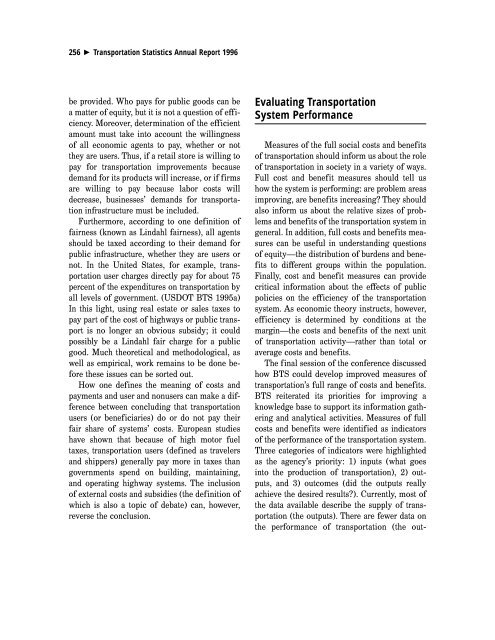table of contents - Research and Innovative Technology ...
table of contents - Research and Innovative Technology ...
table of contents - Research and Innovative Technology ...
You also want an ePaper? Increase the reach of your titles
YUMPU automatically turns print PDFs into web optimized ePapers that Google loves.
256 � Transportation Statistics Annual Report 1996<br />
be provided. Who pays for public goods can be<br />
a matter <strong>of</strong> equity, but it is not a question <strong>of</strong> efficiency.<br />
Moreover, determination <strong>of</strong> the efficient<br />
amount must take into account the willingness<br />
<strong>of</strong> all economic agents to pay, whether or not<br />
they are users. Thus, if a retail store is willing to<br />
pay for transportation improvements because<br />
dem<strong>and</strong> for its products will increase, or if firms<br />
are willing to pay because labor costs will<br />
decrease, businesses’ dem<strong>and</strong>s for transportation<br />
infrastructure must be included.<br />
Furthermore, according to one definition <strong>of</strong><br />
fairness (known as Lindahl fairness), all agents<br />
should be taxed according to their dem<strong>and</strong> for<br />
public infrastructure, whether they are users or<br />
not. In the United States, for example, transportation<br />
user charges directly pay for about 75<br />
percent <strong>of</strong> the expenditures on transportation by<br />
all levels <strong>of</strong> government. (USDOT BTS 1995a)<br />
In this light, using real estate or sales taxes to<br />
pay part <strong>of</strong> the cost <strong>of</strong> highways or public transport<br />
is no longer an obvious subsidy; it could<br />
possibly be a Lindahl fair charge for a public<br />
good. Much theoretical <strong>and</strong> methodological, as<br />
well as empirical, work remains to be done before<br />
these issues can be sorted out.<br />
How one defines the meaning <strong>of</strong> costs <strong>and</strong><br />
payments <strong>and</strong> user <strong>and</strong> nonusers can make a difference<br />
between concluding that transportation<br />
users (or beneficiaries) do or do not pay their<br />
fair share <strong>of</strong> systems’ costs. European studies<br />
have shown that because <strong>of</strong> high motor fuel<br />
taxes, transportation users (defined as travelers<br />
<strong>and</strong> shippers) generally pay more in taxes than<br />
governments spend on building, maintaining,<br />
<strong>and</strong> operating highway systems. The inclusion<br />
<strong>of</strong> external costs <strong>and</strong> subsidies (the definition <strong>of</strong><br />
which is also a topic <strong>of</strong> debate) can, however,<br />
reverse the conclusion.<br />
Evaluating Transportation<br />
System Performance<br />
Measures <strong>of</strong> the full social costs <strong>and</strong> benefits<br />
<strong>of</strong> transportation should inform us about the role<br />
<strong>of</strong> transportation in society in a variety <strong>of</strong> ways.<br />
Full cost <strong>and</strong> benefit measures should tell us<br />
how the system is performing: are problem areas<br />
improving, are benefits increasing? They should<br />
also inform us about the relative sizes <strong>of</strong> problems<br />
<strong>and</strong> benefits <strong>of</strong> the transportation system in<br />
general. In addition, full costs <strong>and</strong> benefits measures<br />
can be useful in underst<strong>and</strong>ing questions<br />
<strong>of</strong> equity—the distribution <strong>of</strong> burdens <strong>and</strong> benefits<br />
to different groups within the population.<br />
Finally, cost <strong>and</strong> benefit measures can provide<br />
critical information about the effects <strong>of</strong> public<br />
policies on the efficiency <strong>of</strong> the transportation<br />
system. As economic theory instructs, however,<br />
efficiency is determined by conditions at the<br />
margin—the costs <strong>and</strong> benefits <strong>of</strong> the next unit<br />
<strong>of</strong> transportation activity—rather than total or<br />
average costs <strong>and</strong> benefits.<br />
The final session <strong>of</strong> the conference discussed<br />
how BTS could develop improved measures <strong>of</strong><br />
transportation’s full range <strong>of</strong> costs <strong>and</strong> benefits.<br />
BTS reiterated its priorities for improving a<br />
knowledge base to support its information gathering<br />
<strong>and</strong> analytical activities. Measures <strong>of</strong> full<br />
costs <strong>and</strong> benefits were identified as indicators<br />
<strong>of</strong> the performance <strong>of</strong> the transportation system.<br />
Three categories <strong>of</strong> indicators were highlighted<br />
as the agency’s priority: 1) inputs (what goes<br />
into the production <strong>of</strong> transportation), 2) outputs,<br />
<strong>and</strong> 3) outcomes (did the outputs really<br />
achieve the desired results?). Currently, most <strong>of</strong><br />
the data available describe the supply <strong>of</strong> transportation<br />
(the outputs). There are fewer data on<br />
the performance <strong>of</strong> transportation (the out-

















